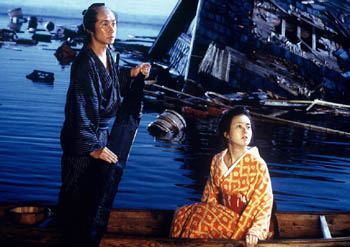![[Metroactive Movies]](http://metroactive.com/movies/gifs/movies468.gif)
[ Movies Index | Show Times | Silicon Valley | Metroactive Home | Archives ]
My Geisha
Akira Kurosawa's last script finally surfaces in Kei Kumai's 'The Sea Is Watching'
By Richard von Busack
FEW posthumous screenplays by celebrated directors have more than traces of the great man who wrote them. It's only guesswork whether this is because an artist's powers are in decline in old age or the script contained details that would have been worked out later. (In any case, the middling level of so many of these posthumous movies rebukes the idea that a movie is all there on paper before the shooting starts.)
The Sea Is Watching, based on Akira Kurosawa's last screenplay, is a relatively modest melodrama with a disaster-movie finish. It maintains, in its stout, old-fashioned way, that a noble working-class spirit is more important than the honorable silk of a samurai clan. Nothing shocking here, but since the myth of the samurai is one that George Lucas lapped up and barfed back (in his "Jedi"), this moral might need revisiting.
Kurosawa derived his script from a novel by Shugoro Yamamoto, who wrote the source works for Kurosawa's Dodes'ka-den, Red Beard and Sanjuro. While the gold-hearted whore is a cliché often railed against, it's true that without some kind of basic liking for human beings, no prostitute will survive in the business long--without the succor of hard drugs, anyway.
O-Shin (Nagiko Tono), who has joined the brothel because her family is sick, keeps falling for the well-spoken customers. Early in the film, during a storm, a samurai named Fusanosuke (Hidetaka Yoshioka) materializes at the brothel's doorstep. O-Shin hides him from the night watchman who wants him (he's escaped from a drunken brawl, in which a stranger was seriously wounded or maybe killed).
Disgraced and cast out by his father, Fusanosuke takes consolation from O-Shin, who feels inferior to such a noble lord. Offhand, the samurai implies that she can be purified if she stops turning tricks. O-Shin is nurtured by her fellow geishas, who give her money to survive without working until this samurai returns one day. When he finally does show up, Fusanosuke is no longer in disgrace. Rather, he's newly wrapped in the kind of arrogance that doesn't even recognize itself as arrogance. But the story continues, with the young geisha's faith in humanity eventually rewarded.
Considering that director Kei Kumai made one of the best-remembered Japanese movies about the lives of prostitutes--a 1975 picture called Sandakan 8--there's craftsmanship in his observation of the life at a seaside brothel shortly before the arrival of Commodore Perry.
The Sea Is Watching seems Westernized, not just because of the soundtrack music (which sounds like Chuck Mangione live at the Megalomart). Some of the more traditional Japanese directors might hit a scene in the instant immediately before or after some terrible emotional turning point. Kumai takes us through every confrontation. His direction made me miss the circumspection of a lot of Japanese cinema. Like a sex or violence scene, a terrifically emotional scene might be all the more fascinating if it took place in our imaginations.
At the same time, Kumai's tendency for nailing down what happens extends to the visuals, and that is a plus. He observes the slightly saggy way the too-gaudy kimonos hang on the working girls and how these girls pester passersby, latching onto them with a death grip when business is slow. We can see that the Ashi no Yi brothel may be as good as brothels get in this remote port town, but it's not glamorous. When the weather has totally cut off the customers, an atmosphere of languor and humidity descends like a layer of mosquitoes.
Even the moment of comedy relief works: a scene of interjected jolliness when a pair of the proverbial visiting firemen come by for some music. One of the firefighters sings a song that's a Japanese cousin of the much-recorded folk ballad (titled everything from "Four Days Drunk" to "Drunkard's Special" to "Cat Man Blues") about the guzzler whose wife tells him there's a cat in the bed, in order to cover up the presence of her lover in hiding.
The Sea Is Watching kicks up an old-time movie climax, a distant cousin of the rainy fights in Rashomon and The Seven Samurai. The weather is a character in the story, up to a typhoon ending where this "Floating World" literally becomes a floating world. Whether the last of Kurosawa, or perhaps the most of Kuma, The Sea Is Watching is a compelling costume drama of the sort that's vanishing from Japanese film in the name of the global film style. Here's a reminder that no more Kurosawa also means no more Kurosawa films.
[ Silicon Valley | Metroactive Home | Archives ]
Copyright © Metro Publishing Inc. Metroactive is affiliated with the Boulevards Network.
For more information about the San Jose/Silicon Valley area, visit sanjose.com.
![]()

Take Me on a Sea Cruise: Ryosuke (Masatoshi Nagase, left) tackles the waves with O-Shin (Nagiko Tono) in 'The Sea Is Watching.'
The Sea Is Watching (Unrated; 119 min.), directed by Kei Kumai, written by Akira Kurosawa, based on a story by Shugoro Yamamoto, photographed by Kazuo Okuhara and starring Nagiko Tono and Hidetaka Yoshioka, opens Friday at Camera 3 in San Jose.
Send a letter to the editor about this story to letters@metronews.com.
From the July 24-30, 2003 issue of Metro, Silicon Valley's Weekly Newspaper.